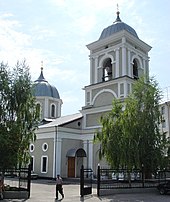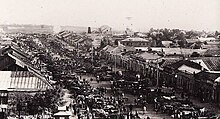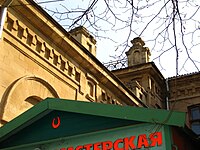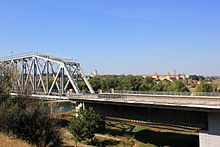Bender (city)
| Tighina / Bender ( rum. ) | |||
|
Бендеры ( Russian ) |
|||
| Бендери ( ukr. ) | |||
|
|||
| State : |
|
||
| Rajon : | Bendery district | ||
| Founded : | 1408 | ||
| Coordinates : | 46 ° 50 ′ N , 29 ° 28 ′ E | ||
| Height : | 15 m. ü. M. | ||
| Area : | 97.29 km² | ||
| Residents : | 93,751 (2010) | ||
| Population density : | 964 inhabitants per km² | ||
| Time zone : | Eastern European Time | ||
| Telephone code : | (+373) 552 | ||
| Postal code : | 3200-3252 | ||
| Website : | |||
|
|
|||
Bender ( Russian Бендеры Bendery ; also Tighina, Cyrillic Тигина ; Ukrainian Бендери Bendery ) is a city in Transnistria and the Republic of Moldova on the western bank of the Dniester River (Romanian Nistru ; Russian Dnestr ) . Control of the city has been exclusively with Transnistria since 1992.
With 93,751 inhabitants (as of 2010) it is the second largest city in the internationally unrecognized state of Transnistria and takes fourth place among the most populous cities in Moldova. Together with the nearby Tiraspol and some surrounding communities, Bender forms an agglomeration with just under 350,000 inhabitants.
name of the city
Bender or Bendery was first mentioned in 1408 in an East Slavic document under the name Тягянакача ("Tjagjanakatscha"). For a long time the city belonged to the Principality of Moldova and was named Tighina there . When the Ottomans took the city in 1538, it was renamed Bender . In 1812, Bender became part of the Russian Empire, which from then on used the name Bendery ( Russian Бендеры ) as its official name. After the First World War, Bessarabia was annexed to Romania and the old name Tighina was reintroduced. This changed when the city fell to the Soviet Union in 1940. There were two official languages in the Moldovan SSR, Moldovan (Romanian) and Russian. In Russian, the city was officially called Bendery again, in Moldovan now Bender , as the Soviet Union associated the name Tighina with Romanian nationalism.
The Transnistrian authorities stuck to the Soviet naming after 1991 and have since tried to enforce Bendery as the international name of the city. In the Republic of Moldova, the name Bender is used in official documents . The term Tighina dominates among conservative and nationalist circles in Moldova and Romania . In the city itself, this term is only rarely used, even among ethnic Moldovans.
geography
Bender is characterized by the continental climate , with cool winters and hot summers. To the northwest of the city lies the Hîrbovăț forest, one of the largest forest areas in Moldova.
history
The place was first mentioned in 1408 as "Тягянакача" ("Tjagjanakacha") in an Old East Slavic document. The city belonged to the Principality of Moldova until 1538 and was known there as Tighina. Prince Ștefan cel Mare had a fort built there as early as the beginning of the 16th century . In 1538 the city was conquered by the Ottoman Empire under Suleyman I , annexed and transformed into a Turkish Reâyâ . Bender then belonged to the Ottoman Eyâlet Silistra . The new rulers built the fort into a fortress , which they named Bender (after the Turkish term for the gate ). Possibly the term was derived from the Persian bandar [ bæn'dær ] for port .
The fortress on the west bank of the Dniester , until then a center of Islam in Moldova , was a refuge for the kings of Sweden and Poland, Charles XII , in 1709 . and Stanislaus I. Leszczyński , who lived there in exile for several years . In 1713 Karl and his followers had to vacate the camp after the scuffle at Bender .

Tsar Nicholas II in Bender, 1916
In 1792 the city of Tiraspol was founded on the other side of the river by the Russian general Alexander Suvorov . In 1812 Bender was also captured by the Russian army and then part of the province of Bessarabia . In the period that followed, many Russians settled in the region, so that Bender soon became a predominantly Russian-speaking city. There was also a large Jewish community in Bender ; In 1910 34.5% of the almost 20,000 inhabitants were Jews .
After the First World War , Bender came to Romania in 1918 as part of Bessarabia, but was also claimed by the short-lived Soviet republic of Odessa at the same time . The Rumcherod , which operates from Odessa , was initially able to gain control over large parts of Bessarabia, including Bender. After Romania's military intervention, fighting broke out across Bessarabia, which Romania ultimately won. On February 7, 1918, Romanian troops captured Bender and advanced to the banks of the Dnestr. Several hundred people were killed. Romanian rule was initially characterized by a repressive character, which was also discussed by the French writer Henri Barbusse , among others . In May 1919 there was a pro-Soviet uprising in Bender , which tried to join the city with the Soviet Union. However, he was knocked down by Romanian troops after just one day.
In the Romanian era, the city's old name, Tighina, was used again as the only official name. The city's economic situation was difficult and life there was characterized by poverty. Romania pursued, increasingly since the 1930s, a policy of de-Russification and cultural Romanization; the settlement of colonists from other parts of Romania was subsidized by the state and the use of Russian was regulated. Nevertheless, Bender retained his Russian-speaking character even during this time and Russians always remained the largest group of the population. In 1930 48.2% of the approximately 31,000 inhabitants were Russians, 26.4% were Jews, 17.4% Romanians / Moldovans and 4.3% Ukrainians. Russian remained the main colloquial language and was by far the most widespread mother tongue in the city.
During the Second World War and as a result of the German-Soviet non-aggression pact , Soviet troops occupied Bessarabia on June 28, 1940. The Moldovan Soviet Socialist Republic was established as part of the Soviet Union with the involvement of parts of the Moldovan ASSR . In June 1941, after the start of the war against the Soviet Union , the so-called Operation Barbarossa , the area again went to Romania. In August 1944, during Operation Jassy-Kishinev , the Soviet Union recaptured the area. During the Second World War, a large part of the Jewish population was murdered and the city suffered massive destruction.
After the war, Bender was part of the Moldovan Soviet Socialist Republic . During the existence of the Soviet Union, the city's population grew steadily, reaching over 138,000 in 1989. Several companies in the manufacturing industry have settled there.
In the course of the dissolution of the Soviet Union in 1991, the former Moldovan Soviet Republic declared its state independence. A union with Romania was publicly debated. In the eastern part of the country, Transnistria , in whose sphere of influence also Bender lay, they were initially interested in remaining with the Soviet Union and after its final collapse tried to achieve a break from the independent Moldova . The background was also the different demographic conditions in Transnistria and the rest of Moldova. In 1992, there was an open conflict between Transnistria and Moldova , in which Moldova tried to gain control of Transnistria by force of arms. The dispute ultimately ended in favor of Transnistria. From July 19 to 22, 1992, Bender was the scene of intense battles in which - depending on the estimate - between 100 and over 400 people were killed. For a short time almost 100,000 people fled the city. Bender was briefly captured by Moldovan troops , but was ultimately recaptured by Transnistrian units . Immediately after the fighting over Bender, the armed struggle for Transnistria ended and both sides agreed on a ceasefire. The Transnistrian-Moldovan control line runs directly around the city.
With the exception of the suburb of Varnița , the Republic of Moldova lost control of the city. The district to the north of Varnița, Severny , remained under Transnistrian control, but is isolated from the rest of Transnistria and has no direct land connection to the rest of the city. The transit between Transnistria and Moldova turns out to be relatively uncomplicated in practice. There are bus routes from the city center to suburbs controlled by the Republic of Moldova and vice versa.
As in many post-Soviet cities, the population has decreased significantly since the early 1990s, but has now largely stabilized.
In 1993 a trolleybus network was opened in the city. Today, Bender is an important traffic junction for transit traffic between Transnistria and Moldova.
population
| Population group | 1897 census | 1930 census | 1989 census | 2004 census |
|---|---|---|---|---|
| Russians | 10,984 (34.5%) | 15,116 (48.2%) | 57,800 (41.9%) | 46,387 (44.2%) |
| Moldovans / Romanians | 2,338 (7.4%) | 5,464 (17.4%) | 41,400 (29.9%) | 25,888 (24.7%) |
| Ukrainians | 6,112 (19.2%) | 1,349 (4.3%) | 25,100 (18.2%) | 18,725 (17.8%) |
| Jews | 10,632 (33.4%) | 8,279 (26.4%) | counted as others | 392 (0.4%) |
| Bulgarians | 112 (0.3%) | 170 (0.5%) | 3,800 (2.8%) | 3,332 (3.1%) |
| Other / not specified | 9,900 (8.2%) | 10,291 (9.8%) | ||
| total | 31,797 | 31,384 | 138,000 | 105.010 |
Bender had been a predominantly Russian-speaking city since at least the second half of the 19th century, but was home to numerous Yiddish-speaking Jews, Moldovans / Romanians and some Ukrainians. Due to its privileged position as the official language, Russian has served as the general lingua franca of the city since the 19th century. Before Bessarabia fell to Russia in 1812, Romanian was in all likelihood the most widely spoken language in the city, although no precise census results are available from this period. Russians have always been the largest ethnic group in the city since the city's first census in 1897. Until World War II, Jews were the second largest population group in the city. Even after 1945, their share in the city was still well above the Soviet average. In the 2004 Transnistrian census, the population was 97,027; the extended urban district with the suburbs Protjagailowka and Gyska had 105,010 inhabitants. In the city (excluding suburbs), 44.2% were Russians , 24.7% Moldovans , 17.8% Ukrainians , 3.1% Bulgarians and 1.1% Gagauz . There were also smaller minorities of Belarusians , Jews , Russian Germans and other minorities. Almost 7% of the population gave no information about their origin.
In 1989 the population was still 138,000. Due to the Transnistria conflict , however, the population fell sharply, especially in the early 1990s. In the meantime, however, it has partially stabilized again. The ethnic composition of the urban population has also changed somewhat since 1989: The proportion of Jews has fallen sharply, as in the entire former Soviet Union. The proportion of the population of Moldovans has also fallen slightly since 1989, while the percentage of Russians in the city has increased slightly.
Economy, infrastructure and sport
As a business location, Bender is of relatively great regional importance. Several companies are located here, such as the largest brewery in Transnistria, the shoe manufacturers Floare and Tighina, and the electronics company Moldawkabel for the electrical industry. The Transnistrian State University , based in nearby Tiraspol , has a branch in the city.
There is a trolleybus network in Bender that also connects the city with nearby Tiraspol. Buses and marshrutkas also operate in the city and also go to some suburbs controlled by Moldova, such as Varnița or Hîrbovăț .
The football club FC Dinamo Bender , founded in 1958 , is based in the city and currently plays in the Moldovan second division. He went through several renaming in his club's history and last ran from 2011 to 2014 under the name Tighina Bender .
Personalities
- Iwan Masepa (1639–1709), Ukrainian hetman , died in Bender
- Charles XII. (1682–1718), King of Sweden, lived in the city from 1709 to 1713.
- Stanislaus I. Leszczyński (1677–1766), King of Poland, lived in the city from 1709 to 1714.
- Benderli Ali Pascha and Benderli Mehmed Selim Sırrı Pascha (1771–1831), Turkish Grand Viziers
- Lew Berg (1876–1950), Soviet zoologist and geographer of Jewish descent
- Jerzy Neyman (1894–1981), Polish statistician
- Baruch Agadati (1895–1976), Israeli dancer, choreographer, film producer and director
- Boris Bilinski (1900–1948), costume designer and set designer for films
- Yevgeny Fyodorow (1910–1981), Soviet geophysicist and polar explorer
- The Aharon Davidis family , an Israeli paratrooper general (1927-2012)
- Tamara Buciuceanu (1929–2019), Romanian actress
- Emil Constantinescu (* 1939), former President of Romania
- Anatolij Kuzew (1959-2016), Ukrainian football player and coach
- Anna Gorenko (1972–1999), Israeli-Russian writer
- Ina Gliznuța (* 1973), Moldovan high jumper
- Nicolai Lilin (* 1980), Russian writer living in Italy
- Anastassija Mikultschina (born 1983), Russian actress
- Igor Bugaiov (* 1984), Moldovan football player
- Artyom Khachaturov (* 1992), Moldovan-Armenian football player
photos
Sheriff's supermarket
Others
Individual evidence
- ↑ СОЦИАЛЬНО-ЭКОНОМИЧЕСКОЕ РАЗВИТИЕ ПРИДНЕСТРОВСКОЙ МОЛДАВСКОЙ РЕСПУБЛИКИ 2009 ( Memento of 8 September 2010 at the Internet Archive ), p 74 (as of 1 January 2010)
- ↑ Бендеры. In: The Jewish Encyclopedia (Russian).
- ↑ Публикации - Говорить обо всём ( Memento of 23 September 2009 at the Internet Archive )
- ↑ На стыке воин (1811–1940 гг.) - ГТК ПМР. customs.tiraspol.net, archived from the original on December 20, 2014 ; accessed on May 21, 2017 .
- ↑ a b The registered resident population by nationality and mother tongue 1930 in the territory of today's Republic of Moldova, 1930 part of Romania ( Memento of July 20, 2011 in the Internet Archive )
- ↑ ПолитБайки - Тирасполь благодарит Ющенко за план ( Memento from August 20, 2009 in the Internet Archive )
- ↑ Худяков В. В. В цветущих акациях город… Бендеры: люди, события, факты. - Бендеры: Полиграфист, 1999. - С. 377. - ISBN 5-88568-090-6
- ^ Transdniestrian conflict: origins and issues. (PDF; 50 kB) Organization for Security and Cooperation in Europe , June 10, 1994, accessed on April 18, 2018 .
- ↑ Ethnic composition of Transnistria 2004 , Population statistics of Eastern Europe
- ↑ Бендерский пивзавод награжден орденом “Трудовая слава”. In: noi.md. October 22, 2015. Retrieved April 18, 2018 (Russian).
Web links
- Official City Website (Russian)
- Photos by Bender (Russian)
- Plan of the city of Bender during the siege, July 20 to September 16, 1770 ( metadata on the historical map )














